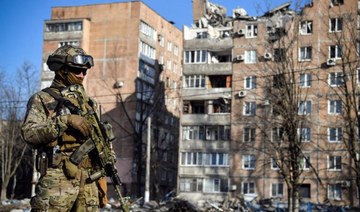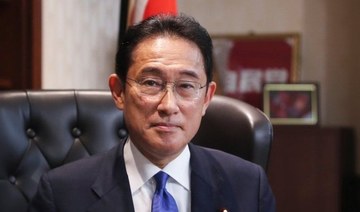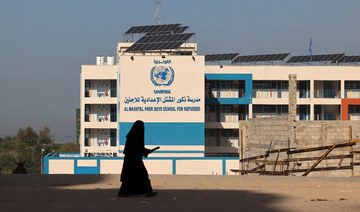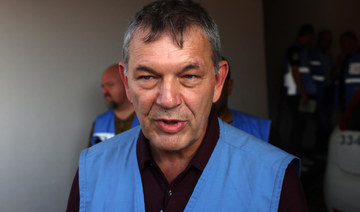KYIV, Ukraine: Russian forces suffered heavy losses in a Ukrainian attack that destroyed a pontoon bridge they were using to try to cross a river in the east, Ukrainian and British officials said in another sign of Moscow’s struggle to salvage a war gone awry.
Ukrainian authorities, meanwhile, opened the first war crimes trial of the conflict Friday. The defendant, a captured Russian soldier, stands accused of shooting to death a 62-year-old civilian in the early days of the war.
The trial got underway as Russia’s offensive in the Donbas, Ukraine’s eastern industrial heartland, seemed to turn increasingly into a grinding war of attrition.
Ukraine’s airborne command released photos and video of what it said was a damaged Russian pontoon bridge over the Siversky Donets River in Bilohorivka and several destroyed or damaged Russian military vehicles nearby — the Ukrainians said they destroyed at least 73 tanks and other military equipment during the two-day battle earlier this week. The command said its troops “drowned the Russian occupiers.”

Russian armored vehicles are strewn on the banks of Siverskyi Donets River after their pontoon bridges were blown up by Ukrainian forces. (Ukraine Armed Forces via AP)
Britain’s Defense Ministry said Russia lost “significant armored maneuver elements” of at least one battalion tactical group in the attack. A Russian battalion tactical group consists of about 1,000 troops.
“Conducting river crossings in a contested environment is a highly risky maneuver and speaks to the pressure the Russian commanders are under to make progress in their operations in eastern Ukraine,” the ministry said in its daily intelligence update.
In other developments, a move by Finland and, potentially, Sweden to join NATO was thrown into question when Turkish President Recep Tayyip Erdogan said his country is “not of a favorable opinion” toward the idea. He accused Sweden and other Scandinavian countries of supporting Kurdish militants and others Turkey considers terrorists.
Erdogan did not say outright that he would block the two nations from joining NATO. But the military alliance makes its decisions by consensus, meaning that each of its 30 member countries has a veto over who can join.
An expansion of NATO would be a blow to Russian President Vladimir Putin, who undertook the war in what he said was a bid to thwart the alliance’s eastward advance. But in the wake of the invasion of Ukraine, other countries along Russia’s flank fear they could be next.
With Ukraine pleading for more arms to fend off the invasion, the European Union’s foreign affairs chief announced plans to give Kyiv an additional 500 million euros ($520 million) to buy heavy weapons.
Ukrainian Defense Minister Oleksii Reznikov welcomed the heavy weapons making their way to the front lines but admitted there is no quick end to the war in sight.
“We are entering a new, long-term phase of the war,” he wrote in a Facebook post. “Extremely difficult weeks await us. How many there will be? No one can say for sure.”
The battle for the Donbas has turned into a village-by-village, back-and-forth slog with no major breakthroughs on either side and little ground gained. In his nightly address Friday, Ukrainian President Volodymyr Zelensky said no one can predict how long the war will last but that his country’s forces have been making progress, including retaking six Ukrainian towns or villages in the past day.

An aerial view shows burnt Russian vehicles on the banks of Siverskyi Donets River following an attack by Ukrainian forces on May 12, 2022. (Ukrainian Airborne Forces via REUTERS)
Fierce fighting has been taking place on the Siversky Donets River near the city of Severodonetsk, said Oleh Zhdanov, an independent Ukrainian military analyst. The Ukrainian military has launched counterattacks but has failed to halt Russia’s advance, he said.
“The fate of a large portion of the Ukrainian army is being decided — there are about 40,000 Ukrainian soldiers,” he said.
The Ukrainian military chief for the Luhansk region of the Donbas said Friday that Russian forces opened fire 31 times on residential areas the day before, destroying dozens of homes, notably in Hirske and Popasnianska villages. He said Russian troops have taken nearly full control of Rubizhne, a city with a prewar population of around 55,000.
In the ruined southern port of Mariupol, Ukrainian fighters holed up in a steel plant faced continued Russian attacks on the last stronghold of resistance in the city. Sviatoslav Palamar, deputy commander of Ukraine’s Azov Regiment, said his troops will hold out “as long as they can” despite shortages of ammunition, food, water and medicine.
Justin Crump, a former British tank commander who is now a security consultant, said Moscow’s losses have forced it to downsize its objectives in Ukraine. He said the Russians have had to use hastily patched-together units that haven’t trained together.
“This is not going to be quick. So we’re settled in for a summer of fighting at least. I think the Russian side is very clear that this is going to take a long time,” he said.
In the first war crimes case brought to trial, Russian Sgt. Vadim Shyshimarin, 21, could get life in prison if convicted of shooting a Ukrainian man in the head through an open car window in a village in the northeastern Sumy region on Feb. 28, four days into the invasion.
Ukrainian Prosecutor General Iryna Venediktova said she is readying war crimes cases against 41 Russian soldiers for offenses including bombing civilian infrastructure, killing civilians, rape and looting. It was not immediately clear how many of the suspects are in Ukrainian hands and how many would be tried in absentia.
In a small Kyiv courtroom, scores of journalists witnessed the start of the wartime proceedings, which will be closely watched by international observers to make sure the trial is fair.
The defendant, dressed in a blue and gray hoodie and gray sweatpants, sat in a small glass cage during the proceedings, which lasted about 15 minutes and will resume on Wednesday.
Shyshimarin was asked a series of questions, including whether he understood his rights and whether he wanted a jury trial. He declined the latter.
His Ukraine-assigned attorney, Victor Ovsyanikov, has acknowledged that the case against Shyshimarin is strong and has not indicated what the soldier’s defense will be.
Shyshimarin, a member of a tank unit that was captured by Ukrainian forces, admitted that he shot the civilian in a video posted by the Security Service of Ukraine, saying he was ordered to do so.
As the war grinds on, teachers are trying to restore some sense of normalcy after the fighting shuttered Ukraine’s schools and upended the lives of millions of children.
In Kharkiv, Ukraine’s second-largest city, lessons are being given in a subway station that has become home for many families. Children joined their teacher Valeriy Leiko around a table to learn about history and art, with youngsters’ drawings lining the walls.
“It helps to support them mentally. Because now there is a war, and many lost their homes. ... Some people’s parents are fighting now,” Leiko said. In part because of the lessons, he said, “they feel that someone loves them.”
An older student, Anna Fedoryaka, monitored a professor’s online lectures on Ukrainian literature, admitting: “It is hard to concentrate when you have to do your homework with explosions by your window.”



























